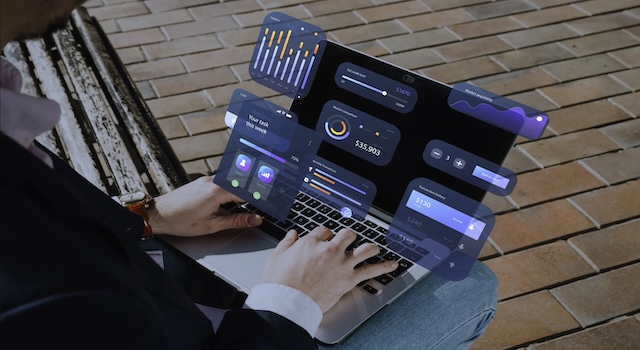Accounting
Business Intelligence
Financial Management
From Spreadsheets to Streaming: How Real-Time Analytics is Replacing Batch Reporting in SaaS

Real-time analytics has become the new standard for business intelligence in the era of cloud-native SaaS platforms. Enterprises are moving away from slow, spreadsheet-based batch reporting toward live, streaming dashboards that provide instant visibility—from field operations to finance teams. The result? Faster decisions, smarter forecasts, and tighter alignment across every level of the organization.
The end of batch reporting
For decades, business reporting ran on batch cycles—daily, weekly, or monthly data updates exported to spreadsheets and static dashboards. This approach was functional but fundamentally reactive. In fast-paced markets, waiting 24 hours for insights is no longer acceptable. Organizations now demand real-time visibility into sales, inventory, spending, and performance metrics.
- Static reports: Require manual refreshes and often contain outdated data.
- Streaming dashboards: Continuously update using live API feeds, ensuring decisions are based on the latest information.
Why cloud-native architecture enables real-time analytics
Cloud-native SaaS architecture allows analytics systems to process data as it arrives—without waiting for traditional ETL (Extract, Transform, Load) cycles. This agility is possible thanks to event-driven pipelines, microservices, and scalable cloud databases.
- Event streaming: Technologies like Apache Kafka and AWS Kinesis capture real-time data flows.
- Serverless computing: Cloud services automatically scale analytics workloads up or down.
- Data fabrics and warehouses: Snowflake, Databricks, and BigQuery unify data streams across applications.
Field-to-finance visibility: connecting every data point
Real-time analytics connects operational data from the field—like production, sales, or logistics—with financial data in ERP systems. This “field-to-finance” visibility bridges the gap between action and insight, empowering organizations to act on what’s happening now, not what happened last quarter.
- Operations: Monitor production or delivery metrics in real time.
- Finance: Track costs, spend, and margins as transactions occur.
- Leadership: Access unified dashboards that show enterprise-wide performance at a glance.
Key benefits of real-time analytics for SaaS enterprises
- Instant insights: Teams no longer wait for manual data refreshes or end-of-day reports.
- Improved agility: Businesses can pivot faster based on live trends or performance shifts.
- Operational efficiency: Automated reporting reduces manual workload and errors.
- Enhanced collaboration: Shared dashboards keep all teams aligned on the same KPIs.
Real-world examples of real-time SaaS dashboards
- Salesforce Genie: Unifies CRM and data streams for instant customer insight.
- Microsoft Power BI Streaming: Provides live dashboards powered by Azure Event Hubs.
- Tableau Pulse: Leverages generative AI to summarize and visualize live metrics.
- Google Looker Studio: Integrates BigQuery for up-to-the-second analytics.
How to transition from batch to real-time analytics
- Audit data workflows: Identify where manual updates or latency occur.
- Adopt event streaming: Move from nightly ETL jobs to continuous data ingestion.
- Modernize the stack: Replace legacy BI tools with cloud-native platforms.
- Centralize data access: Build a unified analytics layer across departments.
- Automate KPIs: Connect dashboards directly to live business systems.
Challenges and considerations
- Data quality: Real-time data is only as good as its source systems.
- Cost management: Continuous streaming workloads can increase cloud costs.
- Governance: Access controls and audit trails must evolve with faster data flows.
- Skill gaps: Teams need training in real-time architecture and streaming analytics tools.
Key performance metrics for real-time success
- Data latency: Time between event creation and dashboard visibility.
- Dashboard uptime: Percentage of time real-time dashboards stay available.
- Refresh frequency: How often data updates per minute or second.
- Decision cycle time: Average time from data insight to business action.
FAQs
What is real-time analytics in SaaS? Real-time analytics continuously collects and visualizes data through cloud-native dashboards for instant decision-making.
How is real-time analytics different from traditional BI? Traditional BI uses batch updates, while real-time analytics provides continuous, event-driven updates.
Which tools support real-time SaaS analytics? Leading platforms include Snowflake, Power BI, Looker, and Databricks for cloud-native, low-latency dashboards.
What industries benefit most from real-time dashboards? Finance, logistics, retail, and manufacturing all rely heavily on live visibility from field to finance.
Bottom line
As businesses demand faster insights and deeper visibility, batch reporting is becoming obsolete. Cloud-native SaaS dashboards powered by real-time analytics enable instant understanding—from the factory floor to the finance boardroom—helping companies anticipate, not just react. The future of business intelligence is streaming, not static.






